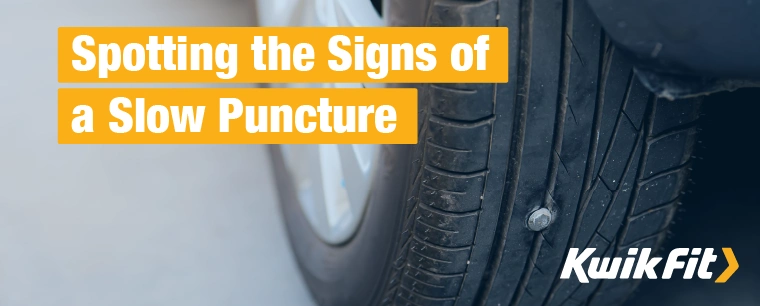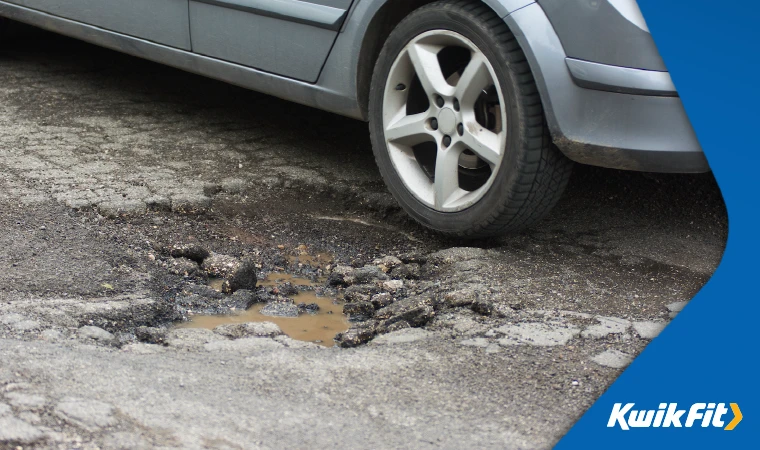Spotting the Signs of a Slow Puncture
Jack Dreyer | Friday 24th November 2023 12:30pm

Keeping your tyres in good condition is crucial for vehicle and driver safety. So, when a puncture occurs, youíll want to sort it out right away to avoid endangering you, your passengers, and other road users.
That being said, slow punctures often go undetected for long periods of time which makes them trickier to deal with than regular punctures or tyre damage caused by potholes.
If you want to know more about this puncture type, how to spot one, and what steps to take to reduce your likelihood of getting one, continue reading.
What is a slow puncture?
A slow puncture refers to a gradual loss of air from a carís tyre as a result of a leak caused by a puncture. Slow punctures are often small, concealed, and caused by objects such as nails or thorns or tyre damage such as a leak in the sidewall of the tyre.
Compared to a regular puncture, a slow puncture can easily remain undetected for a long time. As a result, the undetected damage to the tyre may result in a slow loss of air and finally a drop in pressure.
This means that the tyre canít perform properly and driver safety and comfort are compromised. Bumps on the road surfaces, such as potholes, will have a greater impact on your tyres if youíre suffering from a slow puncture too!
What are the causes of a slow puncture?
The following bullet points list a number of the potential causes of a slow puncture. Knowing these can help you stay vigilant about your tyres, inspecting them, and the environment you keep your car in in the future.
- A sharp foreign object piercing the tyre
- Punctures in the tyre tread area
- Severe impact such as going over a pothole
- Corrosion of the wheel leading to gaps between tyre and rim
- Age and wear of your tyres
- A faulty tyre valve or issues with your valve stem
Sometimes, these scenarios cannot be avoided. However, there are a few things you can do to spot a slow puncture earlier. Undertaking regular visual inspections of your tyres can help with spotting these issues earlier. The earlier these issues are spotted, the easier and more economical they are to fix.

Can you drive with a slow puncture?
It is possible to drive with a slow puncture as, for the most part, the integrity of the tyre remains intact early on. However, we would not advise that you knowingly drive on a punctured tyre due to a number of factors.
- For one, slow punctures affect vehicle handling, making the car more unstable.
- Slow punctures also affect the fuel efficiency of a vehicle as reduced tyre pressure means increased friction and drag.
- Driving on a slow puncture can also cause irreparable damage to the tyre and wheels if done for too long, costing you more than a simple repair in the long run.
- Braking performance is also negatively affected by slow punctures.
While you can drive to your local Kwik Fit centre to get your slow puncture repaired, we would not recommend making any unnecessary journeys as the gradual air loss could become quicker at any moment.
So, to summarise: yes you can technically drive with a slow puncture ó but you can expect to encounter the following issues with vehicle handling if you do.
How to spot a slow puncture
Since slow punctures are far more subtle than regular punctures, it is unlikely that you will detect them by seeing debris sticking out of your tyre. Instead, you are far more likely to notice something is wrong by the feel of your vehicle.
The following sections take you through the 3 possible indications of a slow puncture:
Pulling
If youíre driving on a flat road and relax your grip on the steering wheel and notice the vehicle pulling to the left or the right, itís a sign that the pressure is low in at least one of your tyres. If your tyre pressure remains low, it is likely that you are suffering from a slow puncture.
Vibration
Another sign of a slow puncture is vibrations from your steering wheel. When your tyre loses air, it can cause your wheel to become unbalanced. Due to this, youíll feel a vibration especially when travelling at a high speed.
Responsiveness
If you notice any changes in your vehicle handling, check your tyre pressures. If you feel like your suspension is harder than usual, you should also check your tyre pressures to ensure that they are normal. If youíre used to driving your vehicle regularly, you are likely to notice even slight changes in vehicle handling.
How long does a slow puncture take to go down?
There is no real definitive time to attribute the air leaving a carís tyre as a result of a slow puncture. In fact, it depends on a number of factors such as the tyreís age, pressure, and the cause of the slow puncture.
However, a slow puncture can be as quick as a few days ó but has been known to last even up to a week! For your safety, we recommend getting in touch with your local Kwik Fit centre as soon as you notice you have a slow puncture.
What to do if you have a slow puncture
If you discover a slow puncture, try to avoid making unnecessary or long journeys until you have it repaired.
Book in for an appointment at your local Kwik Fit and let the professional tyre experts sort the problem for you. Contact us today for any questions or visit our tyre repair page to find out more.
Tyre technology
Tyre manufacturers are working to engineer tyres that reduce the risk of punctures. Manufacturers such as Continental have produced tyres that provide extended mobility. An example of this is Self Supporting Run Flat tyres. These tyres allow you to safely continue with your journey for up to 50 additional miles.
Learn more about run flat tyres here.
Concerned about your tyres?
If you are experiencing any handling issues with your car, donít take any chances and pop into your local Kwik Fit. Find your nearest Kwik Fit centre here. In the meantime, keep up to date with the latest tyre and motoring advice on the Kwik Fit blog.
Any facts, figures and prices shown in our blog articles are correct at time of publication.
Featured Articles
Is it Illegal to Drive With One Headlight?
Saturday 19th July 2025
Wondering if itís illegal to drive with one headlight? Learn about the safety risks and penalties of illegal blown bulbs and why you should fix them promptly.
Air Con in EVs & Hybrids: Experts Answer Your Questions
Monday 30th June 2025
Does air con drain EV batteries? Can you use the air con while charging an electric car? Find out the answers to these questions & more from Kwik Fitís experts.
Why Is Your Car Making a Noise? Fixes & Tips
Friday 13th June 2025
When your car starts making unexpected noises, it can certainly be quite disconcerting; it may be nothing to worry about, but hereís what you need to know.









